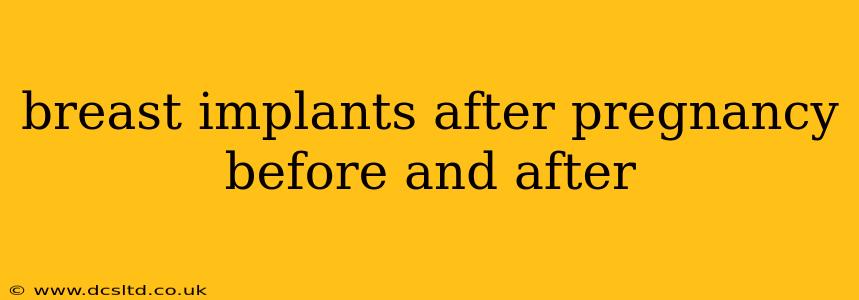Pregnancy and childbirth significantly impact a woman's body, often resulting in changes to breast size, shape, and firmness. For women who already have breast implants, these changes can be particularly noticeable, leading many to consider adjustments or replacements after pregnancy. This article explores the common changes experienced, the options available, and what to expect before and after any surgical procedures.
What Happens to Breasts After Pregnancy?
Pregnancy hormones cause significant breast growth and changes in tissue composition. After delivery, breastfeeding further stretches the breast tissue, often leading to:
- Reduction in breast volume: This is a common outcome after breastfeeding, as the milk ducts and supporting tissues shrink. The effect is more pronounced in women who breastfeed for longer durations.
- Sagging or ptosis: The stretching of ligaments and tissues during pregnancy and breastfeeding can cause the breasts to lose their shape and become more pendulous.
- Changes in nipple and areola appearance: Nipples may become darker and larger, while the areola may become more prominent.
- Asymmetrical breasts: One breast may change more than the other, leading to an imbalance in size and shape.
For women with breast implants, these natural changes can interact with the implants in various ways, sometimes making the implants look less aesthetically pleasing or causing discomfort.
How Do Breast Implants Change After Pregnancy?
The impact of pregnancy on breast implants varies depending on several factors including:
- Type of implant: Saline and silicone implants react differently to pregnancy-related tissue changes.
- Placement of implant: The location of the implant beneath the muscle or on top of the muscle can affect the overall result.
- Individual body composition and elasticity: A woman's natural body composition impacts how much the breast tissue changes and, consequently, how the implants are affected.
Some women may experience implant capsulation (scar tissue forming around the implant) or changes in the implant's position. While these aren't always immediately apparent, they can become more noticeable over time.
Do Breast Implants Need to be Replaced After Pregnancy?
Not necessarily. Many women find that their breast implants remain aesthetically pleasing and functional after pregnancy and breastfeeding. However, some might need corrective surgery to address sagging, asymmetry, or other changes. The decision to replace or adjust implants is highly individual and depends on the woman's desires and her doctor's professional assessment.
Can I Get Breast Implants After Breastfeeding?
Yes, you can. Once breastfeeding is complete and the body has fully recovered from childbirth, it's safe to consider breast augmentation or other implant-related procedures. However, it's crucial to allow sufficient time for the breasts to settle and stabilize before surgery. Your doctor will advise you on the ideal waiting period based on your individual circumstances.
What Are the Options After Pregnancy?
Several surgical options may be considered:
- Breast Lift (Mastopexy): This procedure lifts and reshapes the breasts, improving their position and appearance. It can be performed with or without implant adjustments.
- Implant Exchange: Replacing the existing implants with new ones can restore volume and improve shape. This might involve changing implant size, type, or placement.
- Implant Removal: Some women opt to have their implants removed, either completely or in conjunction with a breast lift.
- Breast Augmentation: If the breasts have significantly reduced in size after breastfeeding, augmentation may be an option to restore volume.
Before and After Photos: Realistic Expectations
It's important to manage expectations when considering any breast implant procedure. Before and after photos can be helpful but should not be used as the sole basis for decision-making. Every individual's results vary based on body type, anatomy, and surgical technique. Consult with a board-certified plastic surgeon to get a personalized assessment and realistic expectations of what can be achieved. They can also show you photos of their previous patients' results.
Finding the Right Plastic Surgeon
Selecting a qualified and experienced plastic surgeon is crucial for achieving optimal outcomes and minimizing risks. Look for a surgeon who is board-certified by a reputable organization, has a proven track record, and is comfortable addressing individual concerns. Don’t hesitate to schedule consultations with multiple surgeons to compare their expertise and approach.
This information is for educational purposes only and should not be considered medical advice. Always consult a qualified healthcare professional for any health concerns or before making any decisions related to your health or treatment.
